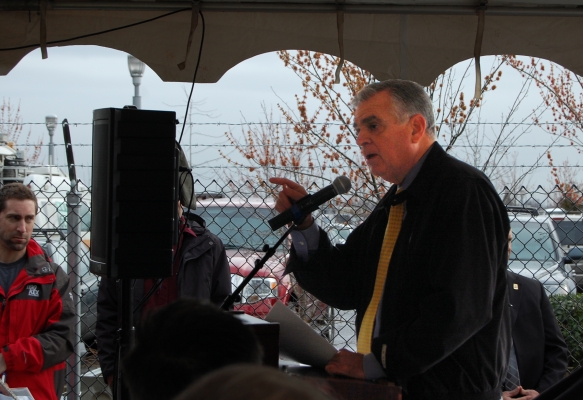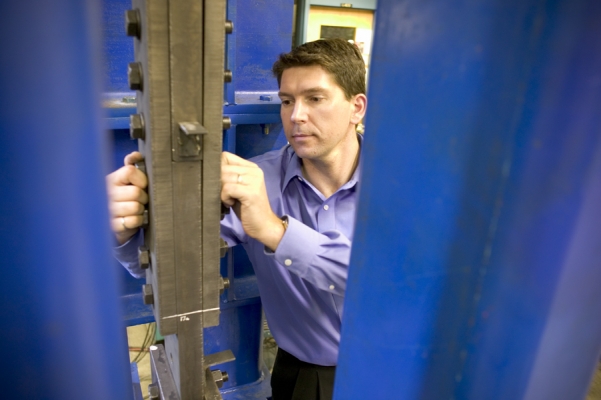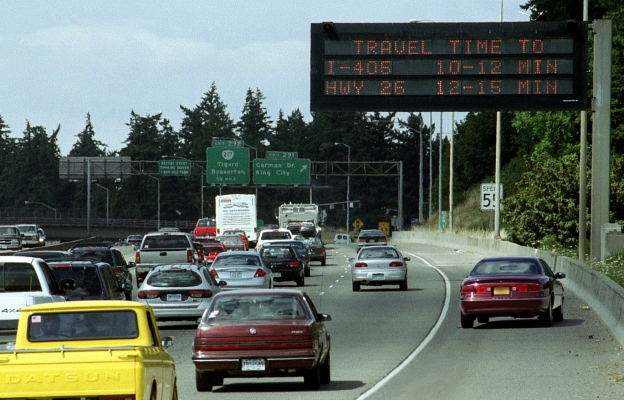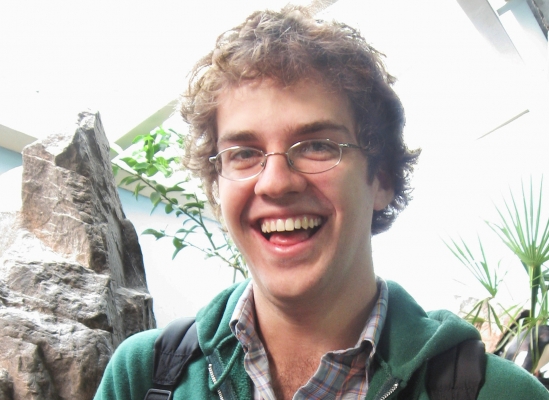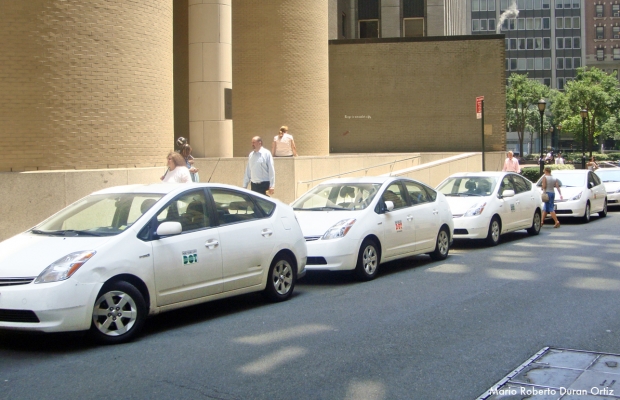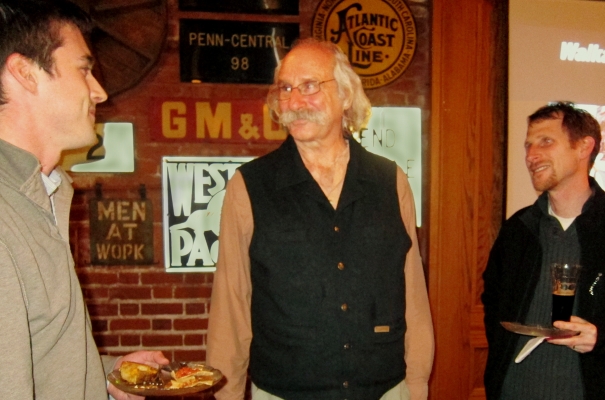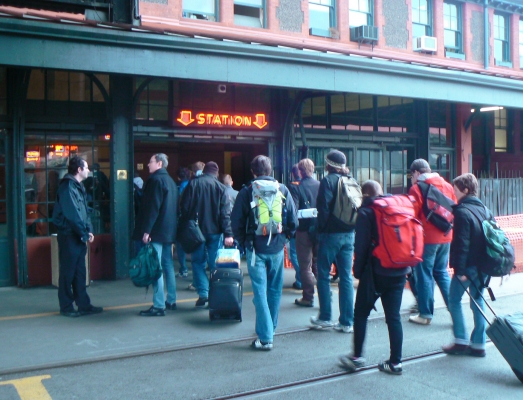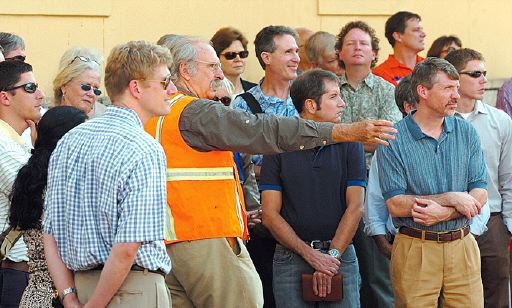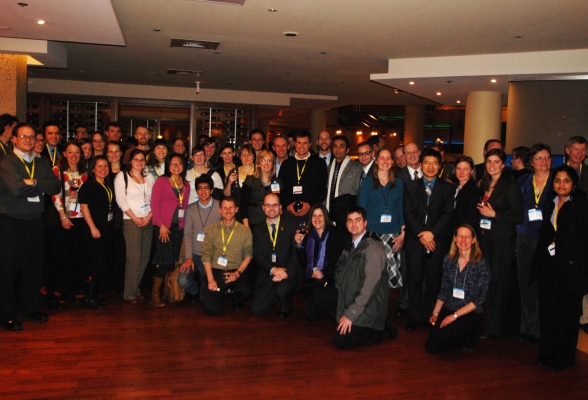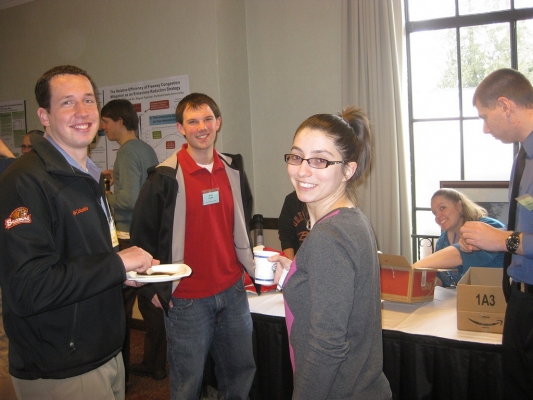In a tent in a parking lot under a freeway bridge, Ray LaHood saw the future of the country’s transportation network Tuesday. The U.S. Secretary of Transportation spoke to reporters, dignitaries and construction workers in the muddy work zone of Southwest Moody Avenue.
Last year, the project to rebuild Moody Avenue received a $23.2 million grant from the federal stimulus package. The project will double the streetcar tracks and add a cycle track and sidewalks. It will also ease connections to a new transit bridge that will carry the Portland-Milwaukie light rail line, the eastside streetcar loop, cyclists and pedestrians.
LaHood, joined by the area's congressional delegation, city and state officials, stressed the jobs the project is creating and the boost for the mix of transportation modes it represents. The project will also reduce congestion, LaHood said, by making transit attractive to current and future residents and employees.
Before construction started along Moody, automobile congestion was virtually nonexistent. However, it’s a heavily trafficked bicycle route connecting Portland’s cycle-friendly downtown bridges with its largest employer, Oregon Health and Science University.
By allowing choices of light-rail train, streetcar, bicycle and shoe leather, the project stands to boost those forms of transportation. If commuters leave their cars at home, that represents a reduction in congestion elsewhere. Of course, the project will also add...
Read moreAs a student at the University of British Columbia, Peter Dusicka pursued earthquake engineering in part because so few others had taken that path. “I was looking for a way to make a difference and looking for areas within civil engineering that seemed immature,” Dusicka said.
There was too much guesswork as to how well the Pacific Northwest’s transportation network would handle the type of subduction zone earthquakes the region is prone to. Now, thanks in part to Dusicka’s research, we know a lot more.
When it comes to the fragility of Oregon’s transportation system, the recent earthquakes around the Pacific Rim provide more insight into a major quake than do models developed for North America, said Dusicka an OTREC researcher and Portland State University associate professor. “The subduction zone earthquake in Oregon, Washington and British Columbia isn’t a threat anywhere else in the U.S.,” he said.
The recent Japanese quake as well as the one in Chile—both subduction-zone quakes—are more instructive. Subduction-zone quakes tend to be larger magnitude, shake longer and affect a larger geographic area than other earthquakes.
The serious earthquake related damage in Japan probably would have been worse had that country’s leaders not been spurred by the 1995 Kobe earthquake. “The Japanese...
It’s a common occurrence: a digital signboard over the freeway tells you to expect a 15-minute trip, but traffic clears and you arrive in 10 minutes. Or, worse, you hit a clog and arrive in 30 minutes.
Sometimes those signboards, called dynamic message signs, are way off, Portland State University researcher Kristin Tufte found. But sometimes that doesn’t matter.
Tufte examined the signboards, called dynamic message signs, along Portland-area freeways in an OTREC project. Drivers typically reach their destinations earlier or later than the signs told them to expect when a so-called “shock wave” forms or dissipates; that is, when traffic suddenly bunches or clears up.
Currently, only three of the 30 or so message signs in the Portland metro area display travel times. Detectors at freeway onramps feed those signs. As a result, large swaths of freeway without onramps also have no data. To be most useful, new message signs would require more detectors in certain areas.
Take the busy Marquam Bridge in Portland, where busy freeways merge and there is no signboard. “There’s no detection for the whole length of the bridge,” Tufte said. “If you really want to have accurate travel times, you have to have detection there.”
As expected, Tufte found that traffic bunching or clearing in blind zones can throw off the accuracy of travel times displayed. Surprisingly, that inaccurate information is...
Read moreUniversity of Oregon master’s student Kory Northrop won an award for the best poster at the recent Region X Student Transportation Conference in Corvallis. Northrop, a second-year Environmental Studies student, along with Planning, Public Policy and Management students Michael Duncan and Ted Sweeney, presented their work Feb. 18.
The poster showcased work the group did as part of the Sustainable Cities Initiative, one of three OTREC-supported initiatives. The group presented its work in creating a bicycle infrastructure database for Salem, Ore.
“Our goal was to create a tool that would help inform and encourage cyclists of all skill and comfort levels,” says Kory. “Our model provides qualitative information about city streets that allows decision makers and citizens to identify streets with high degrees of perceived danger, show where cyclists of varying confidence levels can comfortably ride, and calculate distance-based and comfort-based routing.”
The Region X Student Transportation Conference is a showcase for student transportation research in the Pacific Northwest, which includes Washington, Oregon, Idaho, and Alaska. Region X serves as a microcosm of transportation for the entire...
Read moreFleet managers can benefit from buying electric vehicles under certain conditions, according to a research paper by Portland State University associate professor Miguel Figliozzi. The paper marks OTREC’s first electric vehicle-related research accepted for publication in a peer-reviewed journal.
In the paper, set for publication in the Transportation Research Record, Figliozzi presents a vehicle replacement model that compares the benefits of conventional and electric vehicles under various scenarios. Incorporating electric vehicles makes the most sense for heavily used fleets when gasoline prices are high, assuming electric vehicle tax credits continue.
Until their purchase price drops, electric vehicles won’t make financial sense for fleet managers without some incentives. “Tax credits are important, especially at the beginning, given the higher price of EVs,” Figliozzi said. “The federal tax credit is roughly 20 percent of the (Nissan) Leaf’s list price and it makes a difference.”
The model presented in the paper shows that fleets will start to include a few electric vehicles with gas at $4.10 per gallon, assuming the existing tax...
Read moreBad streets don’t just create frustrating commutes, Dan Burden told a Eugene crowd Feb. 28. They also hurt our health, environment and economy.
Burden, executive director of the Walkable and Livable Communities Institute, spoke as part of the University of Oregon’s LiveMove Transportation Speaker Series. A national authority on bicycle and pedestrian programs, street corridor and intersection design, and traffic calming, Burden started advocating for active transportation 38 years ago.
A healthy and sustainable community is a walkable one, Burden said, and transportation and land-use planning both should serve that goal. “If you want to be a transportation planner, you’d better take a couple courses in land use,” he said. “And if you want to be a land-use planner, you’d better take a couple courses in transportation.”
Well-designed streets are key to healthy communities, Burden said. Wide sidewalks, good landscaping, buffer zones between cars and pedestrians and short crosswalks all create an environment that gets more people walking. In turn, he said, businesses will build to take advantage of foot traffic and existing owners will see their property values rise.
Although established communities offer few opportunities to plan streets from scratch, there are still opportunities to incorporate good design, Burden said. Bad streets can be put on a diet, he said....
Read morePortland State University students visited Seattle March 4 for the second leg of a high-speed rail workshop begun in February in Portland. Daniel Carlson of the University of Washington and Ethan Seltzer of Portland State put together the two-campus workshop to link and enhance courses at their respective universities.
Carlson teaches the transportation and land-use policy course at the University of Washington. The course explores federal and local policies on land use and transportation and focuses on the Puget Sound area as a case study in how a metro area’s growth affects how people get around.
Seltzer, an urban studies and planning professor at Portland State, explores the history and practice of regional planning in his regional planning and metropolitan growth management course. The course includes an individual paper and a group project examining the benefits of high-speed rail in the Cascadia region.
On Feb. 4, both classes met in Portland to examine the Portland State students’ work. On Friday, the University of Washington students reciprocate. A report will synthesize the products of both classes and will be posted on the America 2050 website, www.america2050.org.
The University of Oregon LiveMove Transportation Speaker Series presented Dan Burden Monday, Feb. 28 at Oregon Electric Station, 27 E. Fifth Ave. in Eugene.
Burden is the nation’s most recognized authority on walkability, bicycle & pedestrian programs, street corridor & intersection design, traffic flow & calming, road diets, and other planning elements that affect roadway environments. Burden is also sought after by the health community, promoting neighborhoods, villages, and cities that are designed for more active, interactive, and healthy living.
Burden has 37 years of experience in developing, promoting and evaluating alternative transportation facilities, traffic calming practices and sustainable community design.
If you weren’t one of the 10,000 people who attended the Transportation Research Board’s Annual Meeting in January, there are fifty students and twenty faculty for PSU, UO, OSU and OIT who can tell you what they learned there. OTREC's bright yellow lanyards made our presence especially visible! PSU student Brian Davis blogged about his experience, OTREC’s Jon Makler was interviewed in a local newspaper, and the Oregon “delegation” at the conference was covered by both local and national blogs. Team OTREC filed some daily debriefs, highlighting presentations on topics such as federal stimulus investments in Los Angeles and Vermont’s efforts to address their transportation workforce crisis with returning military veterans (as well as the...
Read moreThe 8th Annual Region X Student Conference was hosted by Oregon State University in Corvallis on Friday and 70 students attended. Conference organizer Jon Mueller said that a surprising number of students from the materials science and economics departments attended and that a significant number of undergraduates from OSU attended parts of the conference.
The conference featured a morning keynote presentation by Galen McGill, manager of the Intelligent Transportation Systems (ITS) unit for the Oregon DOT. The students learned about Oregon’s efforts to confront the challenge of scarce financial resources by applying technology to increase the productivity of existing infrastructure. Galen touched on recent advances in technologies such as OnStar and strategies such as Active Traffic Management, which has been adopted in Seattle and will soon be deployed in Oregon.
The late morning and early afternoon showcased student research. Eight students gave lecture-style presentations in the late morning and there was so much interest and so many questions that the session ran late and into the scheduled lunch hour. The presentations – four from PSU and four from OSU – revealed similar research interests between the campuses. The poster session in the afternoon provided a less structured forum in which the participants could interact.
The later afternoon offered students 3 workshops to attend. The group was divided into three subsets, each workshop was...
Read more
